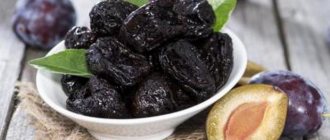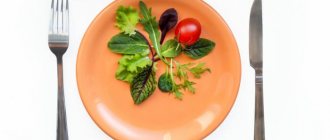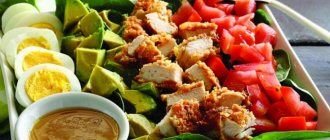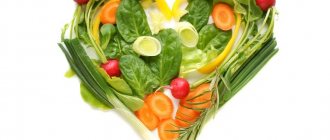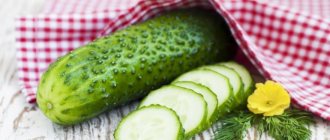Let's choose a goal!
Why are we getting fat? From stress. Why are we losing weight? From them. Paradox? Not at all. No wonder they say: All diseases are from nerves, one is from pleasure! It's true when it comes to obesity. A person begins to gain weight from stress. Or rather, from the desire to get rid of experiences.
A few words about obesity, for those who do not pay special attention to this phenomenon, standing in front of the mirror, who do not count their chins and folds on their stomachs, who order their clothes and underwear not from a special store, because there is nothing like this in stores. That is, for those who have given up on themselves, pretend that they love themselves and others, for those who daily hear maxims like: “There should be a lot of good people,” “Fat means kind!”, “He’s not fat, he’s cozy,” “It’s not a belly, but a bundle of nerves,” etc.
What's good about obesity? Apart from some contrived “virtual” solidity - nothing. The opinion that a thick belly means a fat wallet has long been wrong. It may be so in some places, but this is usually a temporary phenomenon. And it rather resembles a kind of breakthrough: he grabbed money and got drunk to the point of shortness of breath, to the point of immobility. Then he spent the remaining money on doctors to lose weight. What's wrong with obesity? Everything is bad. What all? Let me explain: an extra 30 kilograms is a constant burden on the legs, heart, liver, kidneys, this is the blood supply to the extra 30 kilograms of adipose tissue, feeding it, enriching it with oxygen, and for what? And just like that. In addition to all this, this is the constant production of insulin for unnecessary 30 kilograms of fat, only because the cells that store fat reserves do not touch their own reserves, but eat glucose, like the brain, like blood cells, and they turn excess glucose into fat.
Any normal person gets tired of monotonous constant loads. The body also gets bored with them, and it gives up. The body does not want to be healthy if the owner does not need it. Therefore, obesity is often, if not an endocrine problem at its core, then a craving for pleasure. It doesn’t matter which one, as long as it’s pleasant. And eating food is one of the rudimentary ways of obtaining pleasure. From enveloping food with pseudopods (amoeba) to tearing off fresh goat meat oozing with blood with its fangs (tiger). Food is pleasure.
Who wants to lose weight? Forest of hands, like in school. Where do we start? First you need to define your goal. Why do you need to lose weight? The question seems strange at first glance. In fact, as soon as a person tries to explain why he needs this, there are no specific reasons. You can hear vague mooing and definitions like: “To look better,” “To have good health,” or something else like that. All these are subconscious attempts to divert you from the problem of losing weight. Therefore, when determining your goal, try to find the most specific, precise type of suit that you need to fit into at all costs. What could be more specific? Try it on every day and make sure it's too early. But a suit is a temporary goal, you lost weight, fit into what you wanted, and that’s it? The goal has been achieved - you can go back. Therefore, the goal should not be the only one, and, if possible, long-term. Such goals include the desire to have a certain volume of 90-60-90, or a blood pressure of 120/80, or the banal goal of trimming your toenails and putting on socks yourself. It is advisable to have from 5 to 7 goals. And write them down in beautiful handwriting on the first page of your diary notebook. Actually, we have come to the second stage - this is a diary in which you must note all meals and not only the fact of eating, but also what you ate and how much it was. The question is “HOW MUCH?” Not idle, the normal volume of the stomach does not exceed a liter and a half (depending on the size of the person). The volume of the stomach plays a big role in the formation of appetite, and in overweight people who suffer not only from excess weight, but also from gluttony, the stomach is OVERGROWED. Therefore, the third stage will be CONTRACTION OF THE STOMACH. How to achieve this? There are several ways: Non-surgical - hold out for two weeks, eating no more than 250 grams of food (any) at a time and no more than once every 3-4 hours. Meat is best suited for this. Beef or veal. Surgical - install a 500 g silicone balloon into the stomach. This “ballast” will speed up the feeling of fullness and prevent you from overeating. Usually the balloon is placed for 6 months. Another surgical option is gastroplasty (cutting the stomach to reduce it) - an operation after which the stomach is simply remade to a more acceptable volume, the excess is cut off, the rest works, and the patient loses weight. There are others: gastric banding - to make an “hourglass” out of it - the upper part is small, the lower part is large, you get full quickly, it’s impossible to eat a lot. All these invasive methods are for those who cannot stop themselves from overeating. For you, I will continue to explain how to lose weight and keep it off without extreme methods.
Materials, shapes and dimensions of the container for serving the first course
Don’t think that all deep dishes are soup bowls. For example, there are models decorated with handles. This element is not decorative, but quite functional, because this is not the usual deep bowl, but a tureen or broth. They are placed in the center of the table, and only then the contents are poured onto the plates of household members or guests. Next to it (according to the rules of etiquette) a gravy boat, a dish with pies, bread and a bowl of sour cream are placed.
@yandex.uz
Materials
A variety of raw materials are used to produce utensils for liquid dishes. Moreover, it is impossible to distinguish what is worse or better. The main thing here is to know for what treats and events the service is selected.
The most common options:
- Ceramics. Products made from natural heat-resistant clay. To give the bowls an attractive appearance, they are covered with glaze on top and decorative patterns are applied. The models are quite heavy and massive, but very fragile: they can break if there is a sudden change in temperature or a strong impact. Most ceramic dishes are not dishwasher safe!
- Faience. A type of ceramic, but additionally fired and modernized. The models are heavy, but have a porous structure, and therefore are quite fragile. But with careful handling they will last for a long time.
- Porcelain. Another type of pottery that has undergone repeated firing. After processing, the products are light and durable. Thanks to this, they are highly resistant to aggressive cleaning agents and high temperatures.
Shape and size
The diameter of the top of the products may also vary. Small options - 23-27 cm - are suitable for small children, elderly people and those who are watching their weight.
The soup bowl familiar to many has a completely classic shape - a deep round plate, with a wide top and a narrower bottom. But now on sale you can find original products with the most intricate appearance.
@yandex.uz
Square, oval or rectangular models look unusual. They will become a real decoration for the holiday table or diversify the daily menu. In addition, unusual materials, such as natural wood, are often used to make such products.
It is worth keeping in mind that utensils made of wood absorb food odors well, and therefore require special care using special detergents.
Calorie table for cereals and side dishes
There are a lot of calories in porridge, even when compared with potatoes or pasta, but the benefits of the first course are greater. Any type of cereal is a source of B vitamins and microelements. Eat porridge for breakfast, then the calories will not harm your figure, but will benefit your body. The table shows the calorie content of porridges cooked in water and milk, without added sugar, as well as ready-made side dishes from cereals.
Calorie table for cereals and side dishes
| Name of cereal/porridge | kcal Calories per 100 g | B Proteins, g | J Biry, g | Carbohydrates, g |
| Buckwheat porridge on water | 111,3 | 4,9 | 1,2 | 21,5 |
| Buckwheat porridge with milk | 209,4 | 10,2 | 5,8 | 28,8 |
| Oatmeal on water (Hercules) | 95,7 | 3,1 | 1,4 | 16,7 |
| Oatmeal with milk | 194,5 | 8,9 | 6,1 | 24,6 |
| Semolina porridge with milk | 223,1 | 10,1 | 5,4 | 32,6 |
| Millet porridge on water | 116,7 | 3,6 | 1,4 | 23,2 |
| Corn porridge on water | 109,5 | 2,9 | 0,4 | 24,9 |
| Rice porridge with milk | 214,1 | 8,2 | 5,1 | 31,2 |
| Pea porridge on water | 80,1 | 6,1 | 0,1 | 12,9 |
| Barley porridge on water | 79,8 | 2,6 | 0,3 | 15,6 |
| Millet porridge with pumpkin in milk | 174,1 | 8,3 | 7,1 | 24,9 |
| Boiled pearl barley | 118,3 | 3,4 | 0,5 | 23,6 |
| Boiled rice | 116,1 | 2,3 | 0,5 | 24,8 |
| Boiled beans | 122,6 | 7,8 | 0,6 | 21,4 |
| Boiled green beans (asparagus) | 22,1 | 2,2 | 0,1 | 2,5 |
| Boiled potatoes | 83,4 | 2,3 | 0,1 | 16,9 |
| Fried potato | 198,7 | 2,3 | 9,9 | 23,6 |
| Boiled potatoes in their jackets | 78,8 | 2,3 | 0,1 | 15,1 |
| Mashed potatoes with water | 83,1 | 2,2 | 0,1 | 15,8 |
| Mashed potatoes with milk | 132,2 | 5,1 | 2,4 | 19,9 |
| Boiled pasta (spaghetti, noodles) | 113,5 | 3,6 | 0,4 | 23,4 |
| Stewed cabbage | 98,8 | 2,4 | 5,8 | 9,7 |
It should be understood that in the table all data on the calorie content and nutritional content of ready-made dishes are relative. The bottom line is that the content of carbohydrates, fats and proteins in any product depends on various factors: its variety, recipe features, technological processing.
You must be logged in to post a comment.
| Nutrient | Quantity | Norm** | % of the norm in 100 g | % of the norm in 100 kcal | 100% normal |
| Calorie content | 145.61 kcal | 1684 kcal | 8.6% | 5.9% | 1157 g |
| Squirrels | 9.06 g | 76 g | 11.9% | 8.2% | 839 g |
| Fats | 10.99 g | 56 g | 19.6% | 13.5% | 510 g |
| Carbohydrates | 25.5 g | 219 g | 11.6% | 8% | 859 g |
The energy value of millet porridge with milk (table plate) 250 grams is 145.61 kcal.
Primary Source: Created in the application by the user. Read more.
Reading time: 2 minutes
Rice porridge is one of the most popular and healthy dishes in Russian cuisine. Rice contains vitamins and beneficial microelements necessary for human health, so rice cereal is an indispensable dietary product. Its use helps to normalize the processes of the gastrointestinal tract. The calorie content of rice porridge will depend on the cooking method (milk, water or broth) and what additional ingredients are used.
Quantity of pilaf products for 30 people
To prepare pilaf for 30 people, you will need 3 times more ingredients than for a recipe for 10 people, or 1.5 times more if you take recipe No. 2 for 20 people. But when preparing such a quantity of food, it is necessary to take into account important nuances:
- Preparing and baking dishes. To make pilaf for 30 people, you will need a cauldron of at least 18 liters. The easiest way is to prepare the dish in 2-3 batches (a classic 6-liter cauldron with a narrow bottom holds 1 kg of all ingredients). The second difficulty in using large cookware is that it is almost impossible to heat it on an electric stove. So, in any case, the best option is to cook 3 times. If the dish is made over an open fire, then there are more variations: you can lay out a place suitable for large dishes. It is important to warm up the dishes, because this way the food in it does not burn when the rice is added.
- Proportions of components. In any pilaf you need to adhere to the following proportions: 1 kg of meat, 1 kg of carrots, 1 kg of onions and 800 g of rice. However, you can find other options: 1 kg of meat, 1 kg of carrots, 600-800 g of onions, 1 kg of rice. Vegetable oil per 1 kg of meat is taken at least 250 ml, but if fat is used, then it is reduced by 2 times. When combining oil with fat, the proportions are reduced by a quarter.
- Uneven cooking of rice. This happens just when using a gas or electric stove. When the water boils away from the top after pouring the rice, you need to mix it carefully without touching the zirvak. First, level the surface, then use a slotted spoon to collect the cereal from the edges towards the center, moving in a circle. Then it is leveled again. When preparing pilaf for 30 people, it will not be possible to achieve uniform heating without this procedure.
- Checking liquid evaporation. Before leaving the rice to evaporate, you need to check that all the liquid has evaporated. To do this, the rice is pierced to the bottom in several places with a wooden stick up to 2 cm in diameter. If a clear liquid has collected in the holes, then it is fat without moisture. If the liquid is cloudy, continue to evaporate it.
- Adjusting the fire in a cauldron when cooking over a live fire. To reduce the fire to a minimum, you need to remove burning wood from under the cauldron, and move the coals to the bottom. To keep the rice around the edges of a large dish from cooling, it must be collected in a mound in the center and covered with a lid very tightly - steam should not escape from the dish.
- Rendering lard. This tip can be used when making any recipe: for 5, 10, 30 people. You need to render lamb or pork fat without stirring the cubes. They cut it, put it in a cauldron and left it. The fire is kept almost maximum. Gradually the lard combines into one lump. When the bottom layer turns golden, turn the lump over. This way the product is melted 85% more efficiently and does not acquire a bitter taste.
- Using the right amount of fat. When preparing pilaf, use 10-15% more vegetable oil or animal fat, since removing excess is easier than adding oil to the pilaf after cooking. This is especially important when using steamed rice varieties.
There are dishes that cannot be prepared immediately for 20-30 people. But pilaf is not one of them. If you follow classic proportions and choose the right dishes, you can prepare the right and tasty dish for any number of guests.
Source: plovrus.ru

